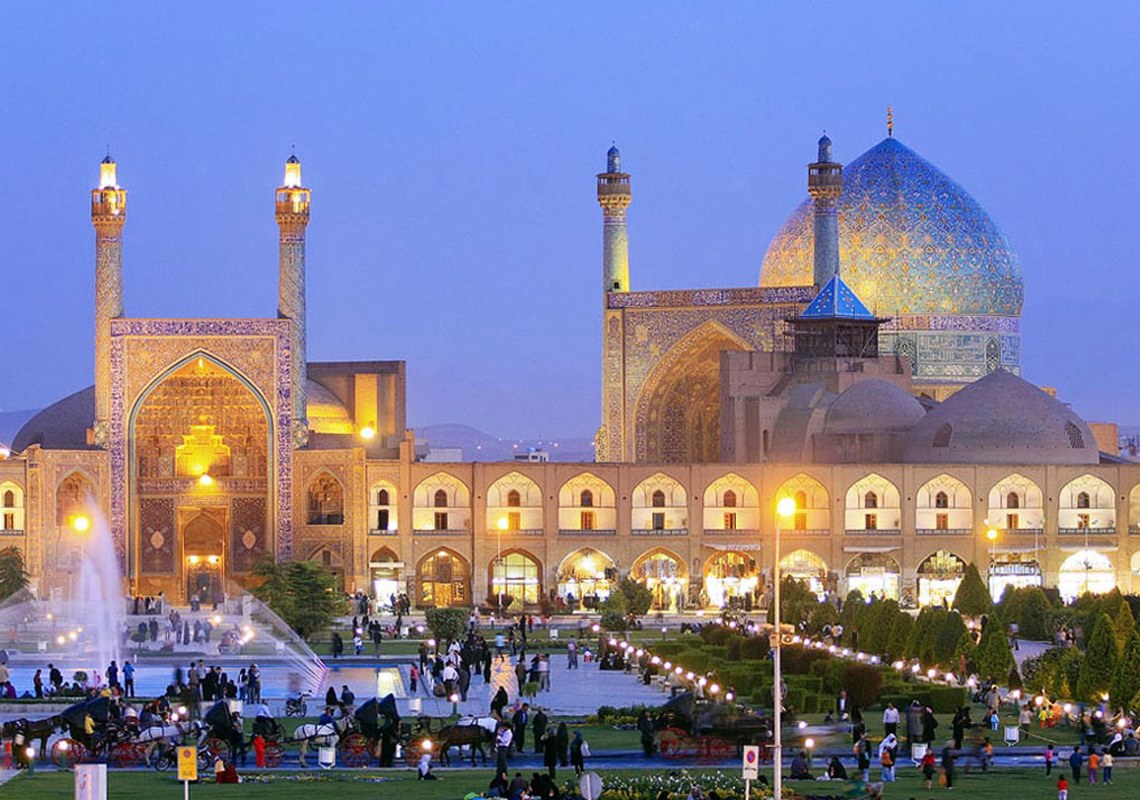Shah (Imam) Mosque in Isfahan, an important feature of Safavi architecture
The Shah Mosque, also known as the Jame Mosque, the Sultaney Mosque and the Imam Mosque, is one of the mosques of the Naqsh-e Jahan Square in Isfahan.
This historical place were built during the Safavi era and it is one of the most important Islamic architectural monuments in Iran. This masterpiece of architecture is tiled in the eleventh century AH. The Shah Mosque was registered as one of the national monuments of Iran in 1931.
Geographical location
Abbasi Jame Mosque is located on the southern side of Isfahan Naqshe-Jahan Square in the Safavi Government Area. It is adjacent to important Safavi buildings such as the Aali-Qapu and Sheikh Lotfollah Mosque and also it is within the range of other important Safavi buildings.
The main entrance to the mosque is located on the south side of the square and other entrances are in the neighborhoods around the building (for faster and easier access to neighborhoods). It is easily accessible from the streets of Hafez and Sepah after crossing the northern side of the square, either by foot or by car.
History of Shah Mosque
This mosque is the most important mosque of Safavi era in Isfahan city which is important both in terms of architecture and a large number of decorations and also political usage. Construction of Abbasi Mosque on the south side of Naqshe-jahan Square began under the command of King Abbas I in the twenty-fourth year of his reign and in order to decorate the square, while they were still constructing other parts of the mosque, they finished the exquisite mosaic tile work.
This eternal masterpiece of Persian architecture and carving in Safavi era contains the last recorded dates in the mosque which is carved in different methods on different objects. It is known that on the last year of reign of King Abbas I and the first year of King Suleiman the decoration of the mosque was shaping and it was completed during the reign of Shah Abbas II.
Famous Safavi historical books such as "Abbasid Worldview" and "Al-Sunni and Al-Aawam" allude to this mosque as the "Abbasi Mosque" and the "New Abbasi Mosque". The inscription on the third floor of the mosque, "Alireza Abbasi", dated to the year 1025, indicates that King Abbas built the mosque and he called it the Jame Mosque, out of his pure property, and he gifted it to his great ancestor- Shah Tahmasb.
The architecture of this mosques as the main element of the city has a special place in post-Islamic architecture and urban planning. The role of mosques in the physical formation of other urban elements such as markets, passages, etc. On the one hand, and the special attention of Islamic rulers to the construction of mosques in all periods, on the other hand, has always made the mosque as a sign of the city.
People who were live close to this mosques used to decorate their historical houses in Iran with more of Islamic roots. Also there are some old houses in Isfahan that were occupied by other type of people. The Abbasi Mosque is also important because of its comprehensively characteristics in the Safavi era. It is approximately southern but the mosque faces southwest. The south porch of the mosque is turned around the back of the mosque, so that the mosque's middle can be seen from the eighth but cannot be accessed directly, one must reach one of the two corridors around the porch. Behind the longer corridors, there are watersheds and a shrine.
The viewer enters the mosque's courtyard on a hierarchical basis by entering the halls of the entrance and vestibule. The main mosque of the Shah, located on the south side of the square below the magnificent shrine and covered with silver and gold, contains poems in the Nastaliq line that were completed and installed in the time of King Abbas I.
The mosque is a four-porch mosque, the mosque's center has a hexagonal fit. In the southeast and southwest corner of the mosque there are two schools, Nasseri and Sulaimaniyah. The former school (Nasseri) were repaired by Nasser al-Din Shah and the other one by King Solomon.
In the southwestern school of the mosque, a simple piece of stone is embedded in a designated place that shows the true midday of Isfahan in four seasons, and is said to have been performed by the famous Sheikh Baha'i scholar and jurist and mathematician in Shah Abbas era. The upper level of the index is in the form of a rectangular triangle, with the triangle chord in the direction that defines the noon, with an adjacent angular side attached to the wall and the other side representing the Qiubla.
This important monument is only 3.1 km away from our house accommodation in Isfahan. Kianpour boutique hotel has easy access to bus station, subway station, bike station and so on. Most of our gusts choose to walk to this destination because on this way they can visit at least 20 other historical sites.







